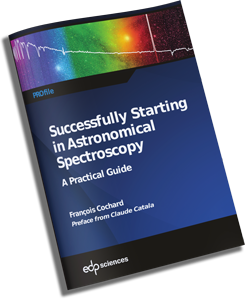Del Sco : 2011 campaign for periastron
Be stars are hot, non supergiants stars whose spectra have shown or still show spectral emission in Balmer line – typically Halpha. Those emissions comes from material around the star – often an equatorial disk or ring. Those stars are very interesting to observe because the understanding of the mechanism(s) which create and sustain such disk could provide information on internal stellar mechanisms and stellar evolutions.
- See our article on Be stars for more information on those stars
- See also our review of active OB stars following the IAUS 272 symposium.
The need for amateur observations of Be star spectra is still very important and long-term follow up is required. To help observers and astronomers, a BeSS (Be Star Spectra) database and a ARASBeAm front-end have been put in place. They facilitate observations with your Lhires III or eShel spectrographs.
If every Be star is unique, Delta Sco is a special one. It is a binary system (about 10.5 years period) and periastron of Delta Sco will take place during spring/summer 2011. It is critical to monitor and study this passage.
Delta Sco was proposed as a Be star in 1990 due to anomaly in the Halpha spectral absorption line. It is during summer 2000 that a bright Halpha emission line was seen, certainly due to the periastron passage at that time.
Timing
Exact timing is not reliable yet and several periastron date have been proposed (april-may 2011, july 4th 2010…) Exact date for periastron is still unknown.
It is then recommanded to observe as soon as possible, when delta Sco become visible at your observing site, and then as frequently as possible.
Even if a timing is getting more precise, observing at least one month before periastron is required.
Radial Velocity
Measuring RV will allow to follow the acceleration of the star when it approaches periastron. RV will switch in about two weeks from approximately +20 km/s à -60 km/s.
Nightly follow up and accurate measures should allow to detect the beginning of the acceleration ande alert – via Spectro-L distribution list – amateur and professional community.
Best accuracy could be on thin and isolated line. Good results have been achieved previously with lines HeII 4200 and HeII 4540. HeII 4540 line would be ideal for eShel spectrographs.
With Lhires III, you could focus on Halpha understanding it would be less precise. Very accurate calibration is required – it is highly recommended to finetune your calibration using atmospheric lines which are numerous in this portion of the spectrum.
What should we see?
At periastron or maybe slightly before, we could see emission becoming more active. If mass is ejected, we could detect it spectroscopically with a new peak appearing and moving along due to Doppler effect as matter get to the disk and evolve within it.
To track this, continuous observation and early alert on observed spectra will be needed.
So, whenever Delta Sco is visible again at your observing site during spring 2011, make sure to point your Lhires III ou eShel spectrographs right one it !!!
Key references :
- Spectro-Llist : http://groups.yahoo.com/group/spectro-l/
- ARASBeAm : http://arasbeam.free.fr
- BeSS : http://basebe.obspm.fr
Bibliography :
- Tango (2009) ; A new determination of the orbit and masses of the Be binary system δ Scorpii: 2009MNRAS.396..842T
- Pollmann (2009) ; Spektroskopische beobachtungen der h-alpha und der HeI6678-Emission am doppelsternsystem delta Scorpii: 2009BAVSR..58..151P
- Jones et al. (2009) ; The circumstellar envelopes of Be stars: viscous disc dynamics : 2008MNRAS.386.1922J
- Halonen et al. (2009) ; Infrared excess in the Be star {delta} Scorpii : 2008PASP..120..498H
- Carciofi et al. (2006) ; Properties of the δ Scorpii Circumstellar Disk from Continuum Modeling : 2006ApJ…652.1617C
- Miroschnichenko et al. (2003); Spectroscopy of the growing circumstellar disk in the {delta} Scorpii Be binary : 2003A&A…408..305M
- Miroschnichenko et al. (2001) ; Spectroscopic observations of the δ Scorpii binary during its recent periastron passage: 2001A&A…377..485M

